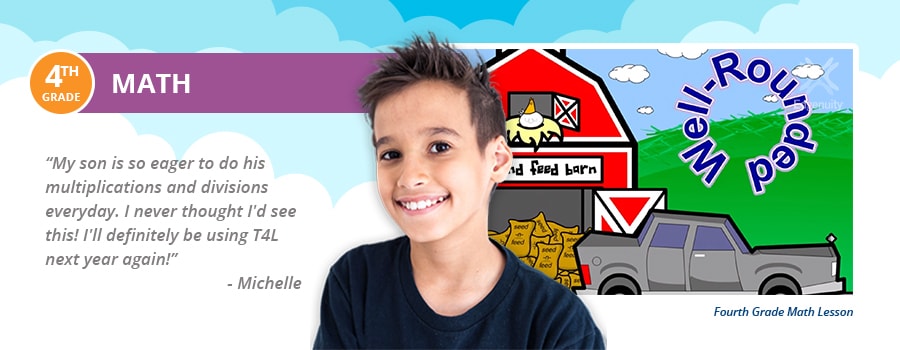Fourth Grade Homeschool Math Curriculum
The choice of a fourth grade math curriculum is an important one. It can be a “turning point” year in terms of either feeling successful or frustrated with math. Students will start to learn that there is more than one way to solve a math problem, and they will begin applying what they are learning in math to real world issues.
On this page, you will get an overview of what your child should know going into the new school year, as well as the upcoming fourth grade math objectives.
What Math Should a Fourth Grader Know?
Fourth graders are expected to have gained the following skills before they start the year:
- Addition and subtraction with regrouping
- Understanding place value
- Solving problems with decimal points
- Memorizing math facts with the help of fact families
- Creating a number sentence or equation from a word problem
- Finding perimeter and area of a shape by counting units
- Familiarity with both the traditional and metric systems
Do you recognize some gaps in these areas? Your Time4Learning subscription includes access to both the grade below and above your subscribed level. You may feel free to have your child go back and practice some areas in the previous grade level that need strengthening.
Fourth Grade Math Curriculum Objectives
In fourth grade, math instruction should focus on number theory and systems, algebraic thinking, geometrical figures and objects, measurement of length, weight, capacity, time, and temperature, and data analysis and probability.
Some of the specific fourth grade math learning targets include:
- Estimating sums and differences using rounding and compatible numbers.
- Defining multiples, and list multiples of a given number.
- Identify factors of a given number and common factors of two given numbers.
- Solving addition and subtraction problems involving money.
- Exploring the idea of a variable by solving for an unknown quantity in an equation (early algebraic thinking).
- Plotting a point given an ordered pair or writing the ordered pair of a point shown on a coordinate grid.
- Finding perimeter, area, and volume.
- Identifying the mean, median, mode, and range from a set of data or a graph.
Check out how Time4MathFacts (included in your subscription) fosters strong math fact fluency through interactive and gamified lessons that keep students engaged and mastering addition, subtraction, division and multiplication.
Time4Learning’s Fourth Grade Online Math Lessons
Convert numbers containing two to nine digits from standard form to expanded form and vice versa.
Write numbers up to nine digits using oral cues and written cues.
Order numbers up to nine digits and compare numbers using the symbols , and =.
Round numbers to the nearest ten, hundred, thousand, ten thousand, and hundred thousand.
Add whole numbers (4-digits, up to 3 numbers).
Subtract 4-digit numbers with multiple zeros.
Estimate sums and differences using rounding and compatible numbers.
Define multiples, and list multiples of a given number. Identify common multiples of two given numbers.
Multiplication will be used to solve problems.
Interpret a multiplication equation.
Multiply 1-digit numbers with 2-digit and 3-digit numbers. Use partial products and mental multiplication as strategies.
Multiply 2-digit numbers with 2 and 3-digit numbers.
Multiply multiple factors.
Identify factors of a given number and common factors of two given numbers.
Find whole-number quotients and remainders with one-digit divisors. Illustrate and explain the calculation by using equations, standard algorithms, and models
Divide two-digit dividends by one-digit divisors, with and without remainders.
Find whole-number quotients and remainders with one-digit divisors, using strategies based on place value, the properties of operations, and/or the relationship between multiplication and division.
Divide dividends up to four-digits by one-digit with and without remainders (include quotients with 0’s).
Solve one-step and two-step word problems in which remainders must be interpreted.
Division will be used to compare.
Solve two-digit division problems with and without remainders.
Apply understanding of place value when solving problems involving multiplication by 10 or 100 and division by 10 or a multiple of 10.
Find the average of a set of numbers.
Match parts of a set and parts of a whole with equivalent fractions with denominators up to 12.
Identify improper fractions, and convert between improper fractions and mixed numbers.
Express a fraction with denominator 10 as an equivalent fraction with denominator 100.
Recognize equivalent fractions. Reduce fractions to lowest terms.
Simplify improper fractions to whole numbers using models.
Explore fractions that simplify to whole numbers.
Explore fractions that simplify to whole numbers.
Order fractions with like and unlike denominators 1 through 12 and compare fractions using the symbols , and =.
Learn how adding fractions is joining parts related to the same whole, and how subtracting fractions is separating parts related to the same whole.
Solve word problems involving addition of fractions with like denominators by using fraction models and equations.
Solve word problems involving subtraction of fractions with like denominators by using fraction models and equations.
Decompose a fraction into a sum of fractions with the same denominator in more than one way using a visual fraction model.
Decompose an improper fraction into a sum of fractions with the same denominator in more than one way and record each decomposition with an equation.
Add and subtract fractions with like denominators.
Add and subtract mixed numbers with like denominators.
Add and subtract fractions with unlike denominators up to 12.
Add two fractions with respective denominators 10 and 100.
Add a unit fraction multiple times.
Recognize multiples of a fraction.
Multiply a fraction by a whole number using visual models and equations.
Solve word problems involving multiplication of a fraction by a whole number by using visual fraction models and equations to represent the problem.
Order decimals and compare the values of two decimals using the signs , and = up to the thousandths place.
Read and write decimals as fractions.
Add and subtract decimals through thousandths.
Count and exchange money in amounts up to $100.00. Solve problems that require making change in amounts up to $100.00.
Solve addition and subtraction problems involving money.
Solve multiplication and division problems involving money.
Identify and apply pattern rules using sequences of related numbers (arithmetic, geometric sequence).
Apply the appropriate rule to complete a chart including input/output tables. Solve problems associated with a given relationship using a table of values.
Represent written relationships as expressions and use a variable to represent an unknown quantity in an expression.
Explore the idea of a variable by solving for an unknown quantity in an equation. Example: 3 + a = 7.
Use the Commutative and Associative Properties of Addition and Multiplication to find equivalent expressions or equations containing an unknown quantity.
Define, name, and identify points, lines, line segments, rays and angles.
Identify and classify angles as right, obtuse, or acute.
Understand that an angle is made up of a series of one-degree turns.
Understand how to sketch angles of specified measure using a protractor.
Understand how to measure acute angles using a protractor.
Understand how to measure obtuse angles using a protractor.
Identify polygons, regular polygons, and non-polygons and their attributes.(sides, angles, and vertices) Classify polygons into subsets.
Classify two-dimensional figures based on the presence or absence of parallel or perpendicular lines, or the presence or absence of angles of a specified size.
Classify triangles according to angle size (right, acute, obtuse) and side lengths (equilateral, isosceles, scalene).
Identify the radius and diameter of a circle, and calculate one when given the other.
Identify the attributes of solid figures such as cubes, prisms, pyramids, cones, cylinders, and spheres. (edges, vertices, and faces) Identify and create two-dimensional representation of a three-dime.
Plot a point given an ordered pair or write the ordered pair of a point shown on a coordinate grid.(1st quadrant only)
After being given the distance and navigational directions from the initial point within the first quadrant, write the ordered pair of the final point.
Given a plane figure, identify the similar or congruent figure.
Apply a translation, a reflection, or a rotation to a plane figure. Predict the result. Identify the image of a plane figure as a translation, a reflection, or a rotation.
Classify plane figures as having line symmetry, point symmetry, both, or none.
Tell and show time to the 5 and 1 minute intervals.
Find elapsed time using days and weeks.
Interpret time schedules using minutes, hours, days, and weeks.
Define units of length. (inch, foot, yard, mile) Estimate and compare length. Measure to the nearest quarter-inch.
Convert measurements of length to new units.
After being given navigational directions from the initial point, identify the ordered pair of the final point.
Define units of capacity. (cup, pint, quart, gallon) Estimate and compare capacity.
Convert measurements of capacity to new units.
Define units of weight (ounce, pound, ton). Estimate and compare weight.
Convert measurements of weight to new units.
Read thermometer to nearest 2-degree interval. Compute change in temperature.
Define units of length (centimeter, decimeter, meter). Estimate and compare length. Measure to the nearest centimeter.
Convert measurements of length to new units.
Define units of capacity (milliliter, liter). Estimate and compare capacity.
Convert measurements of capacity to new units.
Define units of mass. (gram, kilogram) Estimate and compare mass.
Convert measurements of mass to new units.
Read thermometer to nearest 2-degree interval. Compute change in temperature.
Find perimeter by counting units and by adding lengths. Measure to find the perimeter. Select appropriate label for measurement.
Find area by counting units. Multiply to find area. Select appropriate labels of measurement.
Compare perimeter and area.
Find volume by counting units. Multiply to find volume. Select appropriate labels of measurement.
Display and interpret data in frequency and cumulative frequency tables, compare data, and draw conclusions.
Display and interpret data in bar and double bar graphs, compare data, and draw conclusions.
Display and interpret data in line and stem-and-leaf plots, compare data, and draw conclusions.
Display and interpret data in a line graph, compare data, and draw conclusions.
Identify the mean, median, mode, and range from a set of data or a graph.
Determine certainty, likelihood, and fairness of events.
Determine and list the possible combinations of an event.
Calculate probability as a fraction.
Solve multistep word problems using the four operations. Represent these problems using equations with a letter standing for the unknown quantity. Assess the reasonableness of answers.
Scope & Sequence Copyright © 2024 Edgenuity, Inc. All rights reserved.
Why Choose Time4Learning Fourth Grade Math Homeschool Curriculum?
Building the proper foundation in math is key to your child’s success in the future. One of Time4Learning’s main goals is to ensure students gain a love of learning while mastering important math skills that will help them succeed and avoid struggles in later years.
Our comprehensive math program for fourth graders combines interactive online lessons, supplemental worksheets and gamified activities that keep them engaged and motivated. Parents can rest assured that their children are getting a quality math education and that all lesson planning and recordkeeping is taken care of for them to just click and print whenever they need.
Learn more about our online fourth grade homeschool curriculum, designed to help your child learn and master their fundamental concepts.







